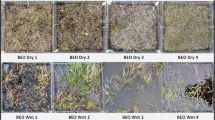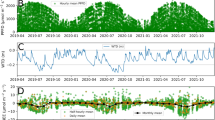Abstract
We measured CH4 fluxes from three major plant communities characteristic of alpine tundra in the Colorado Front Range. Plant communities in this ecosystem are determined by soil moisture regimes induced by winter snowpack distribution. Spatial patterns of CH4 flux during the snow-free season corresponded roughly with these plant communities. InCarex-dominated meadows, which receive the most moisture from snowmelt, net CH4 production occurred. However, CH4 production in oneCarex site (seasonal mean=+8.45 mg CH4 m−2 d−1) was significantly larger than in the otherCarex sites (seasonal means=−0.06 and +0.05 mg CH4 m−2 d−1). This high CH4 flux may have resulted from shallower snowpack during the winter. InAcomastylis meadows, which have an intermediate moisture regime, CH4 oxidation dominated (seasonal mean=−0.43 mg CH4 m−2 d−1). In the windsweptKobresia meadow plant community, which receive the least amount of moisture from snowmelt, only CH4 oxidation was observed (seasonal mean=−0.77 mg CH4 m−2 d−1). Methane fluxes correlated with a different set of environmental factors within each plant community. In theCarex plant community, CH4 emission was limited by soil temperature. In theAcomastylis meadows, CH4 oxidation rates correlated positively with soil temperature and negatively with soil moisture. In theKobresia community, CH4 oxidation was stimulated by precipitation. Thus, both snow-free season CH4 fluxes and the controls on those CH4 fluxes were related to the plant communities determined by winter snowpack.
Similar content being viewed by others
References
Adamsen APS & King GM (1993) Methane consumption in temperate and subarctic forest soils: Rates, vertical zonation, and responses to water and nitrogen. Appl. Environ. Microbiol. 59: 485–490
Archibold OW (1995) Ecology of World Vegetation. Chapman & Hall, London
Brooks PD, Schmidt SK & Williams MW (1997) Winter production of CO2 and N2O from alpine tundra: environmental controls and relationship to inter-system C and N fluxes. Oecologia 110: 403–413
Brooks PD, Williams MW & Schmidt SK (1998). Soil inorganic nitrogen and microbial biomass dynamics before and during spring snowmelt. Biogeochem. 43: 1–15
Castro MS, Steudler PA, Melillo JM, Aber JD & Bowden RD (1995) Factors controlling atmospheric methane consumption by temperate forest soils. Global Biogeochem. Cycles 9: 1–10
Christensen TR (1993) Methane emission from arctic tundra. Biogeochem. 21: 117–139
Cicerone RJ & Oremland RS (1988). Biogeochemical aspects of atmospheric methane. Global Biogeochem. Cycles 2: 299–327
Conrad R (1995) Soil microbial processes involved in production and consumption of atmospheric trace gases. In: Jones JG (Ed) Advances in Microbial Ecology (pp 207–250). Plenum Press, New York
Crill PM, Martikainen PJ, Nykänen H & Silvola J (1994) Temperature and N fertilization effects on methane oxidation in a drained peatland soil. Soil Biol. Biochem. 26: 1331–1339
Dise NB (1996) Methane emission from Minnesota peatlands: spatial and seasonal variability. Global Biogeochem. Cycles 7: 123–142
Dlugokencky EJ, Steele LP, Lang PM & Masarie KA (1994) The growth rate and distribution of atmospheric methane. J. Geophys. Res. 99: 17021–17043
Dörr H, Katruf L & Levin I (1993) Soil texture parameterization of the methane uptake in aerated soils. Chemosphere 26: 697–713
Dunfield P, Knowles R, Dumont R & Moore TR (1993) Methane production and consumption in temperate and subarctic peat soils: response to temperature and pH. Soil Biol. Biochem. 25: 321–326
Dunfield PF, Topp E, Archambault C & Knowles R (1995) Effect of nitrogen fertilizers and moisture content on CH4 and N2O fluxes in a humisol: measurements in the field and intact soil cores. Biogeochem. 29: 199–222
Fisk MC, Schmidt SK & Seastedt TR (1998) Topographic patterns of above- and below-ground production and nitrogen cycling in alpine tundra. Ecology 79: 2253–2266
Fisk MC & Schmidt SK (1995) Nitrogen mineralization and microbial biomass nitrogen dynamics in three alpine tundra communities. Soil Sci. Soc. Am. J. 59: 1036–1043
Frolking S & Crill P (1994) Climate controls on temporal variability of methane flux from a poor fen in southeastern new Hampshire: Measurement and modeling. Global Biogeochem. Cycles 8: 385–397
Fung I, John J, Lerner J, Matthews E, Prather M, Steele LP & Fraser PJ (1991) Three-dimensional model synthesis of the global methane cycle. J. Geophys. Res. 96: 13033–13065
Granberg G, Mikkelä C, Sundh I, Svensson BH & Nilsson M (1997) Sources of spatial variation in methane emission from mires in northern Sweden: a mechanistic approach in statistical modeling. Global Biogeochem. Cycles 11: 135–150
Gulledge J (1996) Doctoral Thesis. Soil Consumption of Atmospheric Methane: Importance of Microbial Physiology and Diversity. University of Alaska, Fairbanks, Alaska
Judd CM & McClelland GH (1989) Data Analysis. Harcourt Brace Jovanovich, Inc., Orlando, FL
Keller M & Reiners WA (1994) Soil-atmosphere exchange of nitrous oxide, nitric oxide, and methane under secondary succession of pasture to forest in the Atlantic lowlands of Costa Rica. Global Biochemical Cycles 8: 399–409
Lashof DA & Ahuja DR (1990) Relative contributions of greenhouse gas emissions to global warming. Nature 344: 529–531
Liblik LK, Moore TR, Bubier JL & Robinson SD (1997) Methane emissions form wetlands in the zone of discontinuous permafrost: Fort Simpson, Northwest Territories, Canada. Global Biogeochem. Cycles 11: 485–494
MacDonald JA, Skiba U, Sheppard LJ, Hargreaves KJ, Smith KA & Fowler D (1996) Soil environmental variables affecting the flux of methane from a range of forest, moorland and agricultural soils. Biogeochem. 34: 113–132
Matson PA, Gower ST, Volkmann C, Billow C & Grier CC (1992) Soil nitrogen cycling and nitrous oxide flux in a Rocky Mountain Douglas-fir forest: effects of fertilization, irrigation and carbon addition. Biogeochem. 18: 101–11
May DE and Webber PJ (1982) Spacial and temporal variation of vegetation and its productivity on Niwot Ridge, Colorado. In: Halfpenny JC (Ed) Ecological Studies in the Colorado Alpine, a Festschrift for John W. Marr. Occasional paper number 37 (pp 35–62). Institute of Arctic and Alpine Research, University of Colorado, Boulder, Colorado, U.S.A.
Mikkelä C, Sundh I, Svensson BH & Nilsson M (1995) Diurnal variation in methane emission in relation to the water table, soil temperature, climate, and vegetation cover in a Swedish acid mire. Biogeochem. 28: 93–114
Moosavi SC, Crill PM, Pullman ER, Funk DW & Peterson KM (1996) Controls on CH4 flux from an Alaskan boreal wetland. Global Biogeochem. Cycles 10: 287–296
Mosier AR, Klemedtsson LK, Sommerfeld RA & Musselman RC (1993) Methane and nitrous oxide flux in a Wyoming subalpine meadow. Global Biogeochem. Cycles 7: 771–784
Neff JC, Bowman WD, Holland EA, Fisk MC & Schmidt SK (1994) Fluxes of nitrous oxide and methane from nitrogen amended soils in the Colorado Alpine. Biogeochem. 27: 23–33
Peterjohn WT, Melillo JM, Steudler PA, Newkirk KM, Bowles FP & Aber JD (1994) Responses of trace gas fluxes and N availability to experimentally elevated soil temperatures. Ecological Applications 4: 617–625
Potter CS, Davidson EA & Verchot LV (1996) Estimation of global biogeochemical controls and seasonality in soil methane consumption. Chemosphere 32: 2219–2246
Prather M, Derwent R, Ehhalt D, Fraser P, Sanhueza E & Zhou X (1995) Other Trace Gases and Atmospheric Chemistry. In: Houghton JT, Meira Filho LG, Bruce J, Lee H, Callander BA, Haites E, Harris N & Maskell K (Eds) Climate Change 1994, Radiative Forcing of Climate Change and An Evaluation of the IPCC IS92 Emission Scenarios (pp 73–126). Cambridge University Press, Cambridge, U.K.
Priemé A & Christensen S (1997) Seasonal and spatial variation of methane oxidation in a Danish spruce forest. Soil Biol. Biochem. 29: 1165–1172
Rodhe H (1990) A comparison of the contribution of various gases to the greenhouse effect. Science 248: 1217–1219
Schimel JP (1995) Plant transport and methane production as controls on methane flux from arctic wet meadow tundra. Biogeochem. 28: 183–200
Schnell S & King GM (1996) Responses of methanotrophic activity in soils and cultures to water stress. Appl. Environ. Microbiol. 62: 3203–3209
Sitaula BK, Bakken LR & Abrahamsen G (1995) CH4 uptake by temperate forest soil: effect of N input and soil acidification. Soil Biol. Biochem. 27: 871–880
Sommerfeld RA, Mosier AR & Musselman RC (1993) CO2, CH4, and N2O flux through Wyoming snowpack and implications for global budgets. Nature 361: 140–142
Striegl RG (1993) Diffusional limits to the consumption of atmospheric methane by soils. Chemosphere 26: 715–720
Striegl RG, McConnaughey TA, Thorstenson DC, Weeks EP & Woodward JC (1992) Consumption of atmospheric methane by desert soils. Nature 357: 145–147
Torn MS & Harte J (1996) Methane consumption by montane soils: implications for positive and negative feedback with climatic change. Biogeochem. 32: 53–67
Walker DA, Halfpenny JC, Walker MD & Wessman CA (1993) Long-term studies of snowvegetation interactions. BioScience 43: 287–301
West AE & Schmidt SK (1998) Wetting stimulates atmospheric CH4 oxidation by alpine soil. FEMS Microbiology Ecology 24: 349–353
Whalen SC & Reeburgh WS (1990a) A methane flux transect along the trans-Alaska pipeline haul road. Tellus 42B: 237–249
Whalen SC & Reeburgh WS (1990b) Consumption of atmospheric methane by tundra soils. Nature 346: 160–162
Whalen SC & Reeburgh WS (1992) Interannual variations in tundra methane emission: a 4-year time series at fixed sites. Global Biogeochem. Cycles 6: 139–150
Whalen SC & Reeburgh WS (1996) Moisture and temperature sensitivity of CH4 oxidation in boreal soils. Soil Biol. Biochem. 28: 1271–1281
Author information
Authors and Affiliations
Rights and permissions
About this article
Cite this article
West, A.E., Brooks, P.D., Fisk, M.C. et al. Landscape patterns of CH4 fluxes in an alpine tundra ecosystem. Biogeochemistry 45, 243–264 (1999). https://doi.org/10.1007/BF00993002
Accepted:
Issue Date:
DOI: https://doi.org/10.1007/BF00993002




